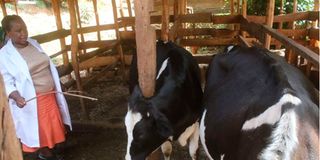Why cows lie on stomach, spread legs 180 degrees

Grace Wangechi tends to her dairy cows at her farm at Ngoru village in Mukurweini.
What you need to know:
- The most common cause of the problem is damage of pelvic nerves during calving. If the calf gets stuck in the cow’s pelvis or it presses too hard on the pelvic wall, the nerve could be crashed or even get cut
Over time, I have seen countless cows unable to stand; a condition we medically call recumbency. It is common in high-producing dairy cattle but can occur in all breeds.
There are many causes of the problem and I have seen almost all its forms. But last week, a professional colleague from Malawi surprised me with a form I have not encountered.
Dr Joyce shared the case on WhatsApp and requested for my opinion. She had not seen the problem before either.
She said the cow was about seven months pregnant. The owner said the animal had been fine the previous day but in the morning, they found it lying on its belly with the hind legs spread out almost 180 degrees. We do not know cattle can do leg splits like gymnasts.
Dr Joyce further added that she had diagnosed milk fever and treated but the legs were still fully split. She tentatively thought the cow had nerve damage but there was no apparent cause for such.
When animals get sick at night, the doctor is disadvantaged because the attendants never get to see the onset of disease signs and progression to full impact. I could tell from the photos Dr Joyce provided that the milk fever issue had been adequately treated. The cow’s muzzle was wet and the animal was alert. It also carried the head strongly projecting forward and held at the right angle.
I diagnosed obturator nerve damage that caused paralysis of the inner thigh muscles. Dr Joyce’s contention with the diagnosis was that the animal was still pregnant.
The obturator nerve has left and right branches. It originates from the spinal cord in the lower back area and enters the pelvic cavity. The nerve runs along the inner side walls of the cavity and exits through a channel in the pelvic bone wall to serve five muscles of the inner thigh.
A major function of nerves in muscles is to deliver messages from the brain to the muscles and from the muscles to the brain to maintain muscle tone and enable the contraction or relaxation of the muscles. This action controls the degree of movement of the joints and, therefore, the whole leg. It also supports the animal to stabilise its various types of movement and resting positions.
The hind legs of a cow on the thigh have two groups of muscles that control movement. The inner thigh has five muscles called adductors. These muscles pull the legs inwards close to the body to prevent damage of the muscles, nerves, blood vessels, joints and tendons. The adductor muscles are served by the obturator nerve.
The outer group of thigh muscles is called the abductors. They pull the leg outward and extend the hip joint like when a cow is kicking or jumping. If the obturator nerve is damaged, it may get paralysed and the adductor muscles relax excessively.
The paralysis causes the abductor muscles to extend the hip joint to its physical limit of 180 degrees as seen in Dr Joyce’s case. The paralysed muscles are unable to support the cow and it goes down, widely splitting the legs. This may also damage the thigh and pelvic muscles as well as joints, tendons and blood vessels. Sometimes it may even cause fracture of the hip joints because of the heavy weight of the animal’s hind quarters. If the nerve paralysis is partial, the cow may be found sitting like a dog and the hind legs stretched towards the side and front.
The most common cause of obturator nerve paralysis is damage to the nerve during calving. If the calf gets stuck in the pelvis or it presses too hard on the pelvic wall, the nerve could be crashed or even get cut.
The nerve could also be damaged if the cow is mounted by a heavier bull and it goes down with the legs splitting widely. Dr Joyce’s case had milk fever which causes paralysis of all muscles. The animal is unable to support its weight and it goes down.
Some animals resist going down and they split their legs to improve stability. The resistance may cause the legs to split as paralysis progresses or if an animal is pushed by another one. Excessive splitting of the legs may also be due to slippery floors where the obturator nerve could get overstretched and damaged. This was not the case for Dr Joyce’s situation since the floor was earthen and dry.
In most cases, cows with obturator nerve paralysis do not recover. There is possibility of severe damage to the many body structures in the pelvic and thigh areas. It is, therefore, recommended such cows be slaughtered for human consumption.
The condition is prevented by ensuring prompt professional assistance for cows with difficult calving. Cows should be housed in shelters with non-slippery floors. Farmers should ensure that their animals are provided feeds well-balanced with calcium and phosphorus. Calcium supplementation should be done for high-yielding animals to ensure sufficient replacement of the one used to form the foetal bones and milk.
Pregnant cows nearing calving should be isolated in a maternity compartment to prevent bullying by others, especially if they develop milk fever. Milk fever cases should be promptly detected and treated before animals become recumbent.





